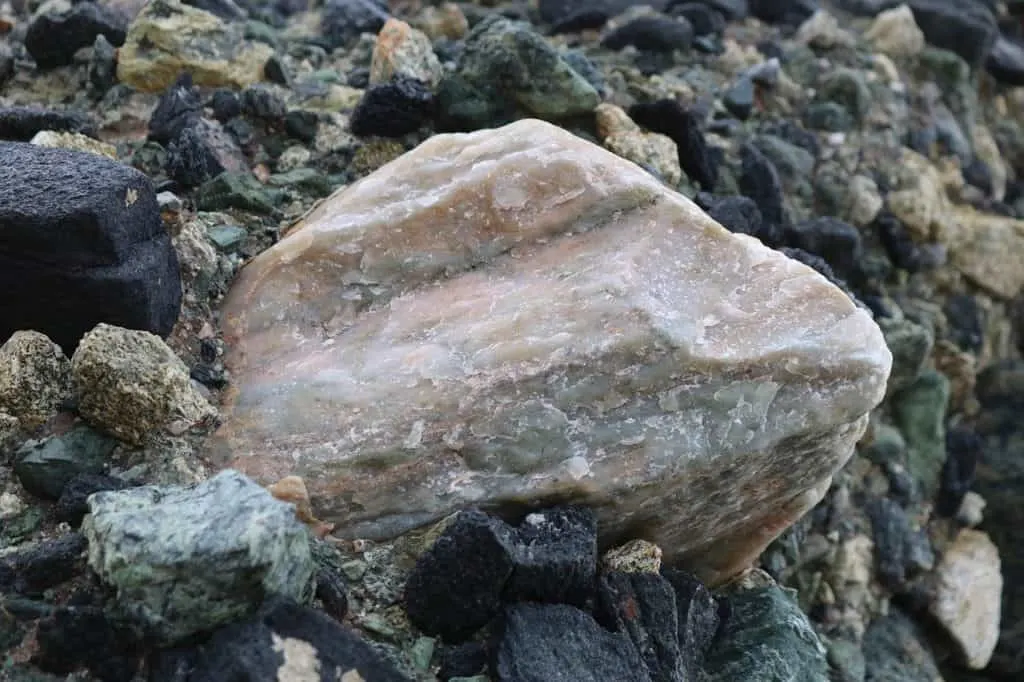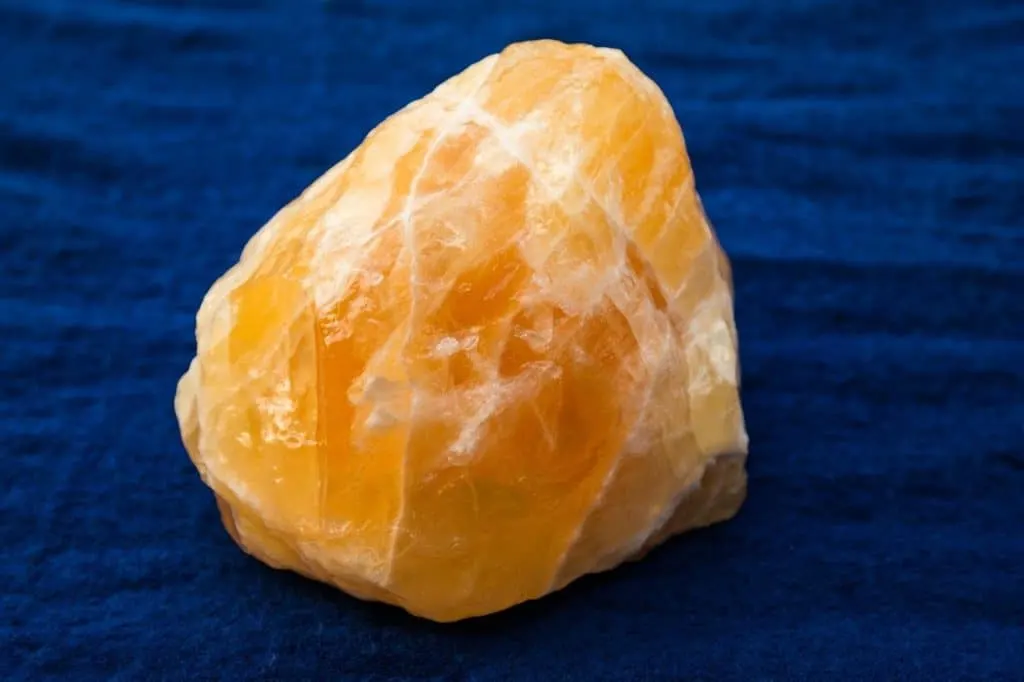As an Amazon Associate, I earn from qualifying purchases with no additional costs for you.
Mountains are built from igneous, metamorphic, and sedimentary rocks, each revealing a chapter in our planet’s history. Igneous rocks form from cooled lava. Sedimentary rocks are created as layers of sand, mud, and even ancient life are compacted. Metamorphic rocks are the result of intense heat and pressure transforming existing rocks. Underlying it all are minerals, naturally occurring solids with unique compositions, forming the building blocks of these geological wonders.
Seven mountain rocks commonly found are gneiss, gabbro, labradorite, diorite, rhyolite, granite, and chert. These rocks contain common minerals such as hornblende, quartz, biotite, calcite, pyroxene, epidote, and apatite. First, identify the rock type, then scrutinize it for the minerals.
Rockhounding in the mountains can be very rewarding, but it helps to research the area’s geology before going out so you know what to expect. You can find this information on government websites covering your planned location or from local information offices.

If you want to check out the best rockhounding tools, you can find them here (Amazon link).
Common Rocks You Can Find In Mountains
Mountains are not great just for hikes, but they are quite popular among all rockhounds as a great rockhounding area. You can find a lot of unique and beautiful rocks in the mountains. Find the list of the most common rocks you can find in mountains in the sections below:
Gneiss
Gneiss is a high-grade metamorphic rock originating from granite, an igneous rock, or shale, a sedimentary rock. It is caused by regional metamorphism due to pressure at tectonic plate boundaries.
Mountain ranges occur at these boundaries, where the tectonic plates push against each other, causing the rock to warp and fold.
Most gneiss has banding of feldspar and quartz. It is often confused with granite. Gneiss is found along the western slope of the northern Cascade Mountains in Washington, US.
Gabbro
Gabbro is an igneous rock that is black or green and is most abundant in deep oceanic crust. However, when mountains form, gabbro can be uplifted from the ocean. Some ancient mountains consist of gabbro, such as the Cullin Hills on the Isle of Skye off the northwestern coast of Scotland.
In the US, gabbro is found in the San Gabriel Mountains in California, and the Raggedy Mountain gabbro group in the Witchita Mountains in Oklahoma.
Labradorite
Labradorite can be found on Black Mountain in the Sierrita and Dos Cabezas Mountains in Arizona. It is part of the feldspar family of rocks and is famous for its blue, green, and yellow iridescence.
It was first discovered in Canada’s Labrador province, where the local Inuit people called it Firestone.
Nowadays, it is also found in other parts of the world, such as the Jones Mountains in Antarctica and Mount Karisimbi in Africa. Varieties of Labradorite include Oregon Sunstone, lynx eye, and spectrolite.
TIP: Real labradorite has a unique play-of-color phenomenon that can hardly be copied in fake labradorites. Find out more about real and fake labradorite in the article below:
Real vs. Fake Labradorite: Focus on These 8 Differences
Diorite
Diorite is an igneous rock consisting of minerals, andesine, biotite, hornblende, and pyroxene. It is usually coarse-grained and forms above a convergent plate boundary.
Quartz diorite occurs in the Klamath Mountains in California and the Blue Mountains in Idaho in the US. It is also found in the Chiricahua Mountains in Arizona and Mount Pawtuckaway in New Hampshire.
Rhyolite
Rhyolite is an igneous rock formed from magma upwellings, rich in silica, deep beneath the Earth. It is light-colored and fine-grained. There is even a ghost town in Nye County in Nevada called Rhyolite, after the igneous rock found in the Bullfrog Hills nearby.
Roundtop Mountain in West Texas is a famous rhyolite intrusion exposed to the surface known for its rare-earth elements. Rhyolite is also found in South Mountain, Pennsylvania.
Granite
Some of the world’s highest mountain ranges, such as the Rockies, Himalayas, and Andes Mountains, are granite. Other mountains in the US, such as the Sierra Nevada Mountain range, Mount McKinley, and Mount Whitney, are mainly granite.
It forms when magma cools deep in the Earth’s crust and sometimes shows as massive exfoliation domes, huge bald rocky outcrops, such as Stone Mountain in Georgia.
Granite is usually a greyish color grey, coarse-grained, and is composed mainly of feldspar, mica, and quartz. It can also be pink, reddish, or even white.
Chert

Chert usually forms on the ocean floor and typically consists of the skeletal remains of microscopic creatures such as diatoms.
Due to geological shifts, thick chert beds occur in deep marine deposits pushed up into mountains such as the Ouachita Mountains in Arkansas and Oklahoma. These mountains are famous for their fine quartz and novaculite, a form of chert.
Chert has a waxy luster and can be brown, red, white, or black. Large chert beds in the mountains can have a folded appearance that shows the enormous pressure it was subjected to when geological forces displaced them.
TIP: At first glance, determination of luster is a piece of cake. It is! But as usual, there are some tricky minerals and pitfalls. Check out the complete guide on testing mineral’s luster in the article below:
Step-by-Step Guide: Testing Mineral’s Luster Like a PRO
Common Minerals You Can Find in Mountains
You can find not only rocks but also interesting minerals in the mountains. Some of the most common minerals found in mountains are quite well known, but the rest may surprise you a little. So, let’s take a look at them.
Hornblende
Hornblende is a common black, dark brown, or green mineral occurring in igneous and metamorphic rocks. It is found in gneiss, rhyolite, granite, schist, and diorite and is considered a major rock-forming mineral.
In the US, shiny plates of hornblende occur in the Ramapo Mountains. It is commonly associated with calcite, apatite, fluorite, quartz, and epidote.
Quartz
Quartz is a widespread group of minerals found in the mountains and can be smoky, pink, white, clear, purple, blue, green, or black.
It is located in sedimentary, igneous, and metamorphic rocks and is best known for its stunning crystal formations. Quartz Mountain is in Greer County in Oklahoma, and smoky quartz can be found in Pikes Peak, Colorado.
Biotite
Biotite is found in metamorphic and igneous rocks and is usually black. However, it can be split into very thin sheets or flakes that glint when sunlight strikes it because it is a dark mica. It has a vitreous, sometimes pearly luster and high iron content, which makes it dark.
Sometimes, biotite produces bright bronze reflections in a gold prospector’s pan that the inexperienced have mistaken for gold. Biotite flakes in rocks have caused similar deceptions.
Calcite

Calcite occurs in many different colors, such as white, yellow, orange, blue, green, and grey. It has a waxy texture and reacts to acids such as vinegar. Varieties of calcite are known by other common descriptive names such as Angel’s Wing, Dog-tooth spar, nailhead spar, and poker chip calcite.
It is frequently found with fluorite, quartz, prehnite, and dolomite. Calcite is located in the Raggedy Mountain gabbro group in southwestern Oklahoma.
TIP: Real calcite is a unique mineral with exclusive properties, making it easily distinguishable from fakes. Check out the differences between real and fake calcite in the article below:
Real vs. Fake Calcite: Focus on These 6 Differences
Pyroxene
The name “pyroxene” hints at this mineral’s fiery origins, combining the Greek words for “fire” and “stranger.” It’s not just one mineral but a whole group, including crystals like augite and enstatite.
Augite: The Rock-Builder
Augite is a major player in the world of rocks, forming large, though often described as “dull”, crystals. You’ll find it in gabbro, diorite, basalt, and some rocks transformed by heat and pressure (metamorphic rocks). Don’t confuse it with the broader term pyroxene – augite is one specific member of this mineral family. Its color ranges from black and brown to green; amazingly, it has even been discovered in meteorites!
Epidote
Epidote might not be a household name, but it’s a common sight in the world of minerals, especially in rocks that have undergone transformation (metamorphic rocks). You might find it hanging out with quartz, feldspar, and chlorite. Its usual color is a yellowish-green to deeper pistachio, but it can also take on brownish-green or black hues.
Things get even more interesting with Unakite! This colorful stone is a mix of green epidote, pink orthoclase, and quartz – a combination that makes it a favorite for jewelry. Its name even has a cool origin story, coming from the Unaka mountain range that stretches along the North Carolina and Tennessee border.
TIP: Gabbro is one of the most common rocks in oceans. Do you know what other gemstones come from the ocean? Find out more in the article below:
Which Gemstones Come From The Ocean? Corals, Pearls, & more!
Apatite
Apatite can form beautiful pale green crystals, but large ones are rare and popular with gem collectors. It can also be brown, blue, pink, yellow, purple, or colorless and occurs in igneous, sedimentary, and metamorphic rocks.
Apatite is the commonest phosphate mineral, and phosphorus is extracted from rock rich in apatite. Phosphorous is used in the manufacture of fertilizers and by the pharmaceutical and chemical industries.
The state of Maine in the US is famous for its apatite crystals and even has a Mount Apatite Park with a network of forest trails linking abandoned quarries, giant boulders, slag piles, and steep ledges. It is a favorite of rockhounds looking for Apatite, Tourmaline, and Quartz crystals.
BTW: Do you want to know more about rock and mineral identification? The books listed below are the best ones you can find on the internet (Amazon links):
- Smithsonian Handbooks: Rocks & Minerals
- Gemstone & Crystal Properties (Quick Study Home)
- Ultimate Explorer Field Guide: Rocks and Minerals (National Geographic Kids)
Tips For Rockhounding in Mountains
Ensure you have permission to collect rocks from mountain sites before you go. Taking rocks from mountains, especially those federally managed and protected, can be illegal unless you have a permit. Don’t take too many because these sites must be preserved for future generations.
Rock collecting may be restricted to certain areas, such as the Deer Hill and Lord Hill Mineral Collecting Areas in the White Mountains.
Mountain rock hunting is allowed along numerous trails in Utah‘s Mineral Mountains in Beaver County. The Southern Palen Mountains in California are also a popular rockhounding area. Many sites only allow the use of hand tools for digging or may not allow digging at all.
TIP: It’s rockhounding time now! Do you know what tools you need for rockhounding? Check out the list of all needed tools and equipment for rockhounding in the article below:
The Complete Guide: All Tools You Need for Rockhounding
